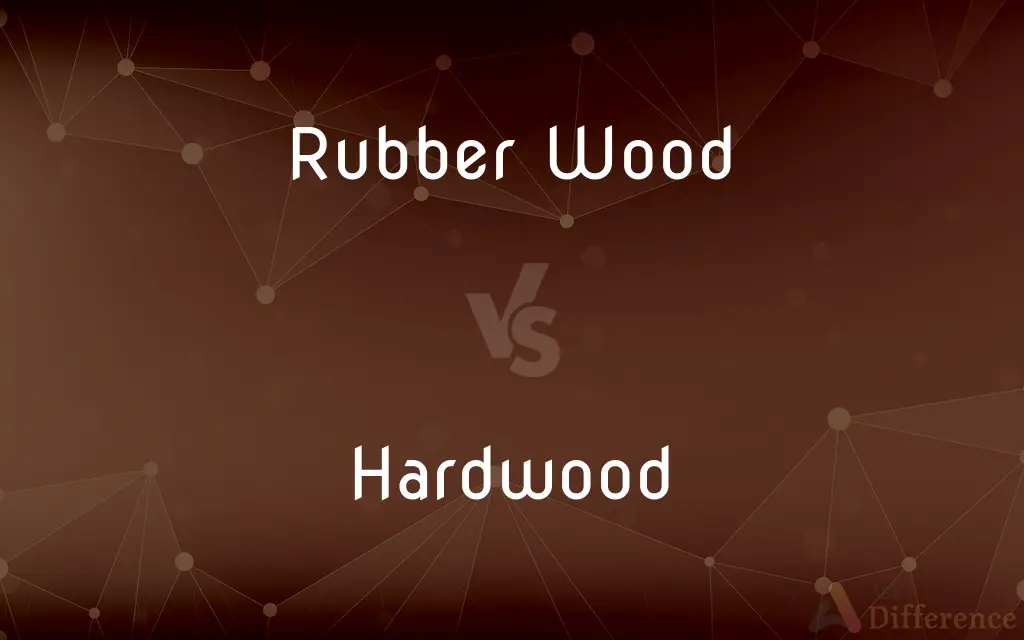Rubber Wood vs. Hardwood — What's the Difference?
Edited by Tayyaba Rehman — By Fiza Rafique — Published on December 14, 2023
Rubber Wood is timber from rubber trees, often used after latex production ceases; Hardwood refers to timber from deciduous trees and some evergreens.

Difference Between Rubber Wood and Hardwood
Table of Contents
ADVERTISEMENT
Key Differences
Rubber Wood is the wood harvested from mature rubber trees, typically those that have stopped producing latex. On the other hand, Hardwood is a term applied to wood sourced from trees like oak, mahogany, or maple, which are deciduous, and certain evergreens like eucalyptus.
Both Rubber Wood and Hardwood are utilized for various applications in the furniture and construction industries. However, while Rubber Wood is mainly a by-product of latex production, Hardwood sources are often specifically grown and harvested for their timber.
When discussing sustainability, Rubber Wood is viewed as an environmentally friendly material because it utilizes trees that would otherwise be discarded after their latex-producing years. Hardwood, though renewable, can be less sustainable depending on logging practices and tree growth rates.
The physical properties of the two differ, with Rubber Wood being moderately hard and suitable for indoor applications. Hardwood, depending on the species, can range from moderately hard to very hard, with some types suitable for rigorous outdoor use.
Cost-effectiveness can be an advantage for Rubber Wood since it is a by-product of the rubber industry. In contrast, certain Hardwood types, especially exotic ones, can be more expensive due to their quality, rarity, and demand.
ADVERTISEMENT
Comparison Chart
Source
Mature rubber trees (Hevea brasiliensis)
Deciduous trees and some evergreens
Primary Use
By-product of latex production
Specifically harvested for timber
Environmental Impact
Considered eco-friendly
Varies; can be sustainable with responsible logging
Durability & Applications
Moderate hardness; mainly for indoor use
Varies; some suitable for rigorous outdoor use
Cost
Generally cost-effective
Can be pricey, especially for exotic species
Compare with Definitions
Rubber Wood
Timber from mature rubber trees.
The dining set was crafted from Rubber Wood.
Hardwood
Often used for high-quality furniture and flooring.
The premium Hardwood desk was a showstopper.
Rubber Wood
Eco-friendly timber choice.
They chose Rubber Wood for its sustainable appeal.
Hardwood
Wood from deciduous trees and some evergreens.
The Hardwood floor gleamed under the light.
Rubber Wood
Moderate hardness and density.
Rubber Wood is perfect for making indoor furniture.
Hardwood
Can be sourced from trees like oak, mahogany, and maple.
The elegant Hardwood cabinet was made of cherry.
Rubber Wood
Light-colored with a tight grain.
The pale hue of the Rubber Wood table complemented the room.
Hardwood
The wood of a eudicot or a magnoliid, such as an oak, maple, or magnolia.
Rubber Wood
Used after latex production ceases.
After the tree stopped yielding latex, it was felled for Rubber Wood.
Hardwood
A eudicot or magnoliid tree.
Hardwood
The wood from any dicotyledonous tree, without regard to its hardness.
Balsa is a hardwood, but a soft hardwood.
Hardwood
(countable) (in more general use) As the preceding, but limited to those that are commercial timbers, and are at least average in hardness.
Ash, hickory and oak are some of the most prominent domestic hardwoods.
Hardwood
The tree or tree species that yields the preceding.
This hardwood has been planted extensively throughout the hills here.
Hardwood
(uncountable) A joint term for the commercial timbers, without distinguishing which.
You should have used hardwood for this window sill instead of this junk.
Hardwood
The sport of basketball, in particular, an indoor basketball court; so named because the floor of an indoor basketball court is normally made of hardwood.
Hardwood
(of a floor) Made of interlocking hardwood boards.
Hardwood
The wood of broad-leaved dicotyledonous trees (as distinguished from the wood of conifers); also items made from such wood; as, decorative hardwood.
Hardwood
Made of the hard-to-cut wood of a broad-leaved tree, as e.g. oak; consisting of a hardwood; as, hardwood floors; - of wood and wooden objects.
Hardwood
The wood of broad-leaved dicotyledonous trees (as distinguished from the wood of conifers)
Hardwood
Made of the hard-to-cut wood of a broad-leaved tree, as e.g. oak;
Hardwood floors
Hardwood
Typically denser than softwood.
Due to its density, Hardwood was perfect for the project.
Hardwood
More resistant to wear and tear than softwoods.
The Hardwood stairs have lasted generations.
Common Curiosities
Can Rubber Wood be used outdoors?
Generally, Rubber Wood is best for indoor applications as it's not as durable as some Hardwoods for outdoor use.
Why is Rubber Wood considered eco-friendly?
It utilizes trees that would otherwise be discarded after latex production ends.
Is Rubber Wood as durable as Hardwood?
Rubber Wood is moderately hard, while some Hardwoods are much more durable and harder.
Is all Hardwood hard?
No, while many Hardwoods are dense and tough, hardness can vary among species.
Are all Hardwoods deciduous trees?
Mostly, but some evergreens also produce Hardwood.
Which is more expensive, Rubber Wood or Hardwood?
It varies, but generally, Rubber Wood is more cost-effective, while certain Hardwoods can be pricey.
Is Hardwood resistant to termites?
Some Hardwoods are naturally termite-resistant, but it varies by species.
What is Rubber Wood derived from?
Rubber Wood is derived from mature rubber trees that have ceased latex production.
What color is Rubber Wood?
Rubber Wood typically has a light hue with a tight grain.
Can I use Hardwood for outdoor decking?
Yes, certain Hardwoods like teak or ipe are suitable for outdoor applications.
Is Rubber Wood good for carving?
Yes, its moderate hardness makes it suitable for carving.
Can Rubber Wood be stained?
Yes, Rubber Wood takes stains well, making it versatile for various finishes.
Why would one choose Rubber Wood furniture?
It's eco-friendly, cost-effective, and suitable for various indoor applications.
Do Hardwood trees grow quickly?
Growth rates vary, with some species growing slower, making them less renewable.
Are Hardwoods always dark-colored?
No, Hardwoods can range in color from light to dark, depending on the species.
Share Your Discovery

Previous Comparison
Un- vs. Non-
Next Comparison
PVR vs. DVRAuthor Spotlight
Written by
Fiza RafiqueFiza Rafique is a skilled content writer at AskDifference.com, where she meticulously refines and enhances written pieces. Drawing from her vast editorial expertise, Fiza ensures clarity, accuracy, and precision in every article. Passionate about language, she continually seeks to elevate the quality of content for readers worldwide.
Edited by
Tayyaba RehmanTayyaba Rehman is a distinguished writer, currently serving as a primary contributor to askdifference.com. As a researcher in semantics and etymology, Tayyaba's passion for the complexity of languages and their distinctions has found a perfect home on the platform. Tayyaba delves into the intricacies of language, distinguishing between commonly confused words and phrases, thereby providing clarity for readers worldwide.











































